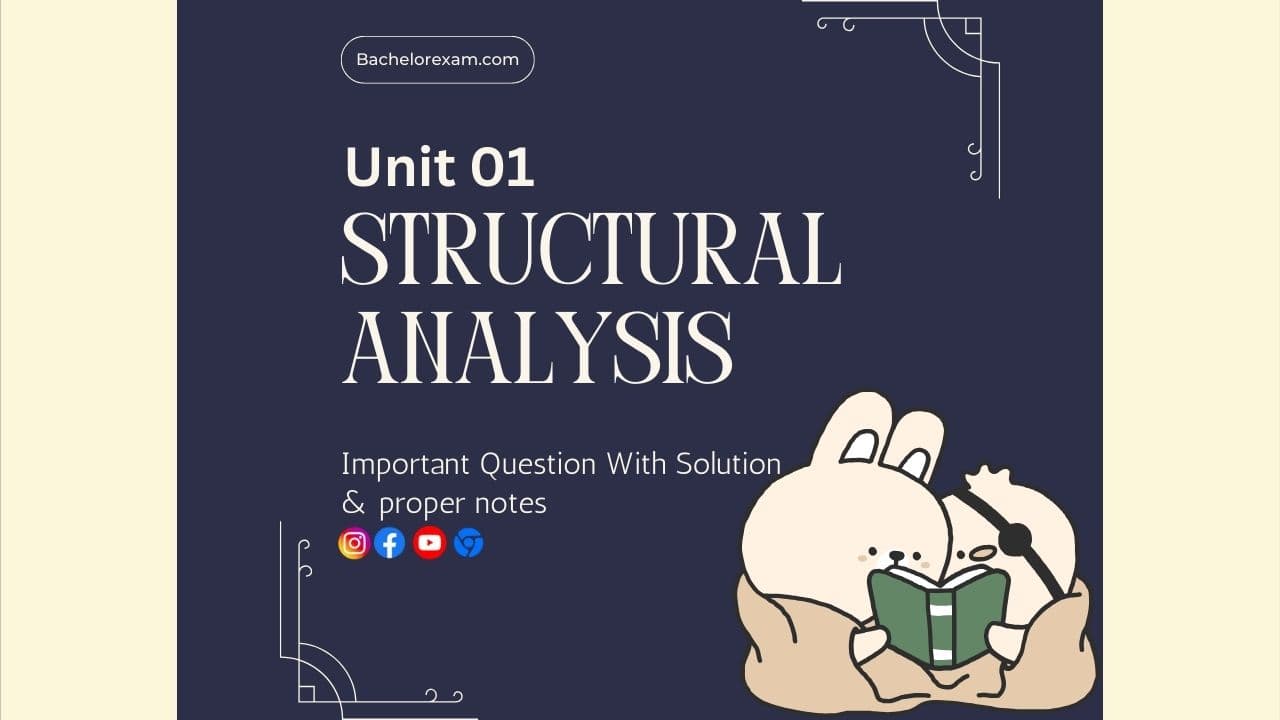Utilise Quantum Notes to improve your structural analysis coursework. For your Aktu Btech examinations, find important, commonly asked questions. Gain academic success with our assistance! Unit-1 Classification of Structures
Dudes 🤔.. You want more useful details regarding this subject. Please keep in mind this as well. Important Questions For Structural Analysis: * Aktu Quantum * B.tech-Syllabus * Circulars * B.tech AKTU RESULT * Btech 3rd Year * Aktu Solved Question Paper
Q1. Define the term ‘Structure’. Also discuss the structural elements.
Ans. A. Structure:
- 1. A structure is a group of linked components used to carry a load. Buildings, bridges, and towers are a few examples of structures in civil engineering.
- 2. The engineer must take into consideration the project’s serviceability, aesthetic appeal, and economic as well as environmental restraints when building a structure.
B. Structural Elements: The common structural elements are as follows:
- 1. Tie rods
- 2. Beamns
- 3. Columns
1. Tie Rods (or Bracing Struts): The structural members that are subject to tensile force are tie rods or bracing struts. Slender rods, bars, angles, or channels are frequently used as tie rods.
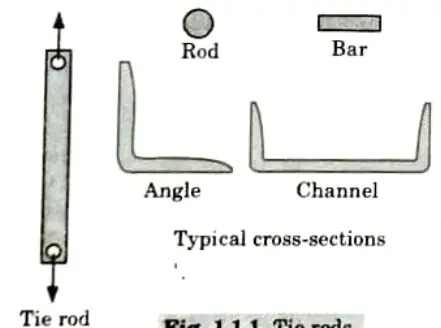


2. Beams:
- i. Beams are typically horizontal members that are straight and utilized largely to support vertical loads.
- ii The beam is described as tapered or hunched when the cross-section varies. The main purpose of beam design is to withstand bending moment.
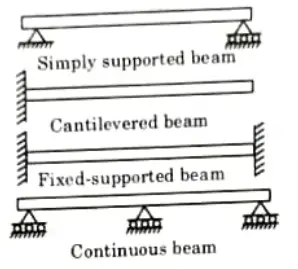


3. Columns: Columns typically resist axial compressive loads and are vertical. Columns that are occasionally subjected to both an axial load and a bending moment are referred to as beam columns.
Q2. What do you understand by kinematic indeterminacy of structures ? Explain in sufficient detail.
Ans. A. Degree of Freedom:
- 1. When a structure made up of numerous parts is loaded, displacements such as rotation and translation occur at the joints.
- 2. The degree of kinematic indeterminacy or the number of degrees of freedom is referred to as the number of independent joint displacement.
B. Kinematic Indeterminacy:
- 1. The total number of degrees of freedom, or degree of kinematic indeterminacy, is equal to the sum of the degrees of freedom in rotation and translation.
- 2. A joint in space has six degrees of freedom because there are six different movements it may make: three linear displacements, one along each reference axis, and three rotations, one about each reference axis.
- 3. Because a free joint in a two-dimensional system has three degrees of freedom two translations and one rotation any joint in a two-dimensional system can have up to three degrees of kinematic indeterminacy.
- 4. The total kinematic indeterminacy of a structure is the sum of all the displacements that the structure’s joints may experience.
Example :



From Fig.
| Joint | Kinematic Indeterminacy (KI) |
| A | 0 |
| B | 2 |
| Total KI | 2 |
Q3. What is the difference between statically determinate and statically indeterminate structure ?
Ans.
| S. No. | Statically Determinate Structures | Statically Indeterminate Structures |
| 1. | The equilibrium conditions are sufficient for a thorough analysis of the structure. | Equilibrium conditions are insufficient for a thorough analysis of the structure. |
| 2. | The material of the structural elements has no bearing on the bending moment at a section or the force in any member. | The material of the structural elements affects the bending moment at a section or the force in a member. |
| 3. | The cross-sectional areas of the components have no bearing on the bending moment at a section or the force in any member. | The cross-sectional areas of the components determine the bending moment at a section or the force in a member. |
| 4. | No stresses are caused due to temperature changes. | Stresses are generally caused due to temperature variations. |
| 5. | No stresses are caused due to lack of fit. | Stresses are caused due to lack of fit. |
Q4. A suspension cable of span 20 m and central dip 2 m is carrying a UDL of 20 kN/n. Find the horizontal pull in the cable. Also find the maximum and minimum tensions in the cable.
Ans. Given: Span, L =20 m, Dip, h = 2 m, Intensity of UDL, w = 20 kN/m
To Find: Horizontal reaction, maximum and minimum tension.
1. Minimum tension in the cable,



2. Maximum tension in the cable,
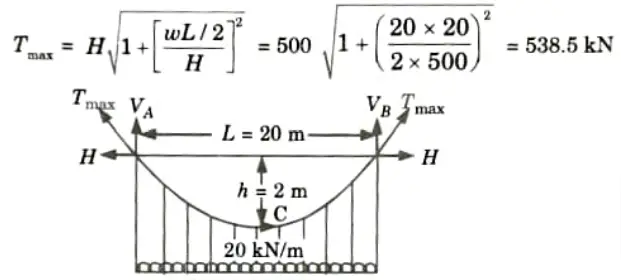


Q5. What do you understand by the term structural load ? Explain different types of loads.
Ans. A. Structural Load: Structural load is consists of following loads:
- 1. Dead Loads:
- i. Dead loads are a fixed part of the structure and are largely time-invariant. For instance, the self-weight of the building, the furnishings, etc.
- ii. Dead loads are inherent in the structure and serve as the fundamental design criterion for all structural systems.
- 2. Live Loads: Live loads are those that change over time and have a variable magnitude. These loads are added on top of any fixed or dead loads. They are commonly referred to as imposed loads.
- 3. Environmental Loads:
- i. These loads are the result of natural phenomena such as wind, earthquakes, floods, landslides, etc.
- ii. Because of the uncertainty surrounding their occurrence, timing, magnitude, and terrestrial circumstances, these loads are typically non-deterministic.
- 4. Man-made Loads: Man-made loads are caused by human activities. These loads are like impact loads, blast loads, dynamic loads etc.
B. Types of Loads: Classification of Loads on the Basis of Direction in which Loads are Acting:
- i. Gravity Loads: Gravity loads, which always act vertically downwards, are the dead loads, live loads, snow loads, and ice loads.
- ii. Lateral Loads: The term “lateral loads” refers to forces that act horizontally, such as wind, earthquake, soil, and hydrostatic pressure forces.
- iii. Directionless loads: Thermal loads, loads due to misfit and blasting loads are known as directionless loads.
2. Classification of Loads on the Basis of Their Variation with Time:
- i. Static or Monotonic Load: Monotonic or static loads are those that behave consistently in the same way across time and do not change over time. Examples include ground pressure, dead loads, building loads, and snow loads.
- ii. Cyclic or Dynamic Loads:
- a. Dynamic or cyclic loads are ones that change over time and have a different sensation.
- b. An illustration would be machine-induced loads, explosion loads, impact loads, and earthquake loads. Dynamic loud noises cause the building to tremble.
- c. A special type of dynamic or cyclic load known as a fatigue load is one that is repeatedly applied to a structure over an extended period of time. Traffic and wave-induced loads, for instance.
Q6. A foot bridge is carried over a river of span 90 m. The supports are 3 m and 12 m higher than the lowest point of the cable. Determine the length of the cable. If the horizontal deck is loaded by UDL of 20 kN/m, find the tension in the cable.
Ans. Given: Span, L = 90 m, Intensity of UDL, w = 20 kN/m,
To Find: Length of cable and tension in the cable.
- 1. Let the vertical reaction at the supports A and B be VA and VB and Hbe the horizontal reaction at each support.
- 2. Resolving the forces on the cable vertically, we have
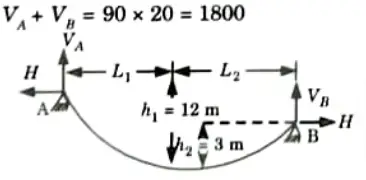





- 5. Taking moments about C’ of the forces on the left side of C, we have,



- 6. Taking moment about point C’ consider the right side of C, we have,



- 11. Maximum tension occurs at the higher support i.e., at A,









Important Question with solutions | AKTU Quantums | Syllabus | Short Questions
Structural Analysis Btech Quantum PDF, Syllabus, Important Questions
| Label | Link |
|---|---|
| Subject Syllabus | Syllabus |
| Short Questions | Short-question |
| Question paper – 2021-22 | 2021-22 |
Structural Analysis Quantum PDF | AKTU Quantum PDF:
| Quantum Series | Links |
| Quantum -2022-23 | 2022-23 |
AKTU Important Links | Btech Syllabus
| Link Name | Links |
|---|---|
| Btech AKTU Circulars | Links |
| Btech AKTU Syllabus | Links |
| Btech AKTU Student Dashboard | Student Dashboard |
| AKTU RESULT (One VIew) | Student Result |
